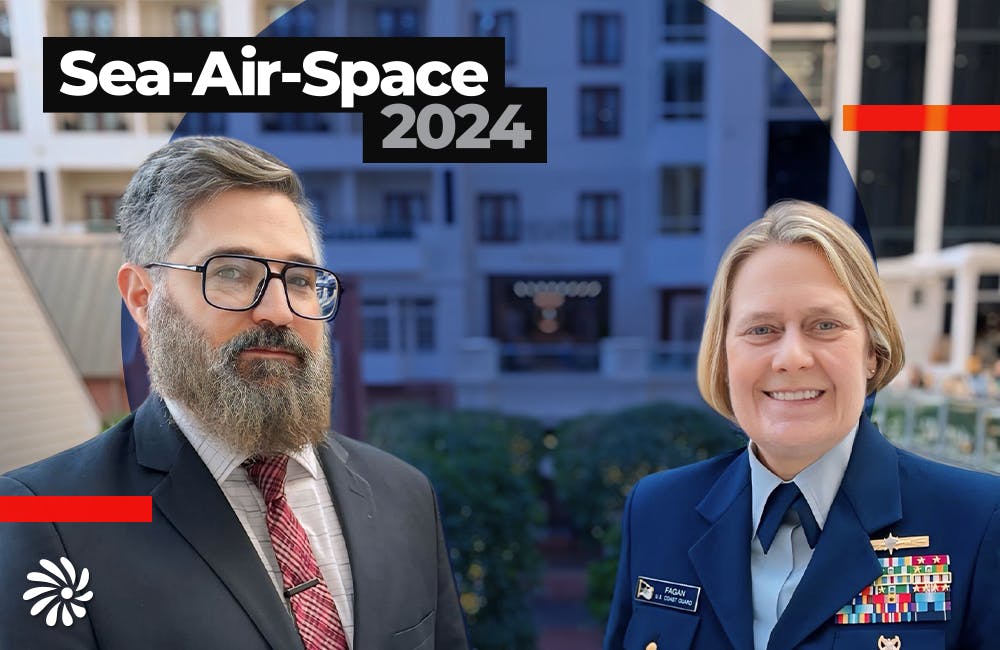5 Takeaways from Sea-Air-Space 2024

Officials from the military services came together at Sea-Air-Space 2024 in National Harbor, Maryland, to discuss the state of American maritime superiority, technological advances and global threats.
Dig into the latest technology insights featuring:
- Coast Guard Commandant Adm. Linda Fagan
- Verizon Senior Director for Defense and National Security David Rouse
- Navy PEO Unmanned Aviation and Strike Weapons Rear Adm. Stephen Tedford
- and more!
Sponsored by:

Technology underpins Coast Guard modernization.

Keeping up with the quick pace of technology is an imperative for the Coast Guard. Commandant Adm. Linda Fagan said that the service is modernizing at speed. She cited artificial intelligence, machine learning and data analytics as capabilities the Coast Guard is leveraging as part of this plan.
“Job one right now is getting our data and data warehouse and catalog in a way that allows us to apply some of those technologies,” Fagan said. “My intent is to continue to bring the organization sort of from the legacy that we were as an organization into the current state and enable the kind of future work that we will need.”

Transforming Marine Corps communications requires collaboration across industries.

Military services need to be able to communicate quickly in even the most austere environments where connectivity can be challenging. The Navy and Marine Corps rely on different systems to best support this. Industry partners see it as an opportunity.
“It’s really looking at kind of the holistic architecture,” said Verizon Senior Director for Defense and National Security David Rouse. “The Department of Navy is more of a enterprise of enterprises needing carrier class type solutions, or for scale and reach on a global basis.”

The Navy is shifting its approach on an AI-enabled unmanned fleet.

The Navy is looking to buy unmanned cooperative combat aircraft (CCA) differently. Instead of focusing on the aircraft itself, officials are aiming to put more emphasis on the CCA sensors and systems during the acquisition process.
Rear Adm. Stephen Tedford, chief of the Program Executive Office Unmanned Aviation and Strike Weapons, said the sea service is trying to keep pace with technology by eschewing proprietary solutions for the next generation of drones.
“It has to be universal, it has to be interdependent, and it has to be interchangeable,” Tedford said.

Navy's CJADC2 initiative is ahead of schedule.

The Navy’s Project Overmatch, the department’s contribution to the Defense Department’s larger CJADC2 mission, is moving faster than expected, according to Naval Information Warfare Systems Commander Rear Adm. Douglas Small.
Small said the project is ahead of schedule, partially because his office has focused on “actually delivering capability, focused on the delivery, but also the training, developing [concept of operations] and how do we use this stuff.”

Military has a data advantage that will push AI forward.

Glen Henshaw, senior scientist for autonomous and robotics systems at Naval Research Laboratory, said the team is examining use cases for artificial intelligence in robots and other autonomous systems. The Defense Department’s large amount of data makes processing it more quickly necessary for decision-making, he noted.
“Maintaining that data is going to be maybe the single most important thing that we do,” Henshaw said. “Leveraging data superiority into AI superiority — there should be a direct pipeline to the chat. One of the challenges is we’ve got to make sure that they stay secure.”





